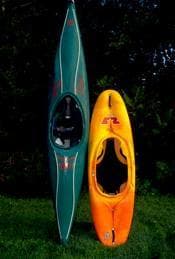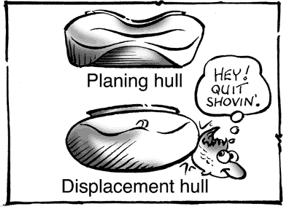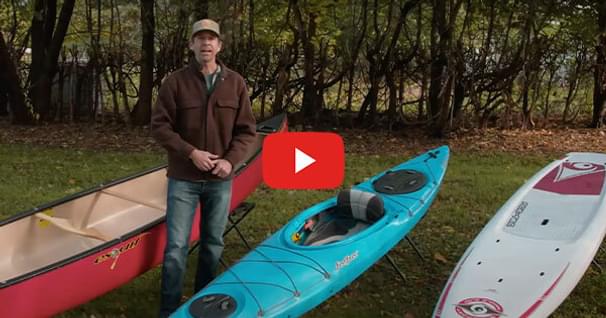Choosing a Whitewater Kayak
The days of long, skinny kayaks shaped like logs with a hole carved into the top of them are gone, and along with them the performance characteristics that a log offers! Boat design is now a sophisticated process that makes use of professional designers, athletes, flashy software packages with digital simulations, and multi-prototype trial runs. Today's boats are shorter (from 1.5m to 3m, or 5 ft to 9 ft), wider (about 40 cm, or 25 in), flat-hulled, and far more thoroughly outfitted than their predecessors. These fundamental changes have afforded the paddler with substantially increased maneuverability, stability, and control.

The first thing we're going to do, is look at the characteristics that have the most effect over the way a whitewater kayak handles.
Rocker
Rocker is the curvature from bow to stern, as viewed from the side. As a general rule, the more rocker a kayak has, the more quickly it will turn. It will also travel through rapids more easily and surf waves with greater ease because the ends won't get caught by the incoming water.
TAHE 10'6 & 11'6 SUP-YAK Inflatables
2-in-1 Kayak & Paddle Board complete packages for single or tandem use.
Hull Shape
There are two types of hulls that you'll find in a whitewater kayak. There are planing hulls and displacement hulls.
Planing Hulls are flat hulls that create a very wide footprint in the water. They are the most common form of kayak hull because they are the most stable, and surf waves incredibly well. The edges of the "planing" hull are bevelled up to the sidewalls at varying angles of aggressiveness; the more bevel, the "softer" the edge, and therefore the more forgiving and less tippy the boat will be when its side is exposed to the current.

Displacement Hulls are rounded hulls. These were once the standard for whitewater kayaks, but have been largely replaced by the preferred planing hull. Displacement hulls track most effectively and are easily tilted on edge, but they aren't as stable or as manoeuvrable as planing hulls.
Boats designed specifically for playboating (surfing and performing various other acrobatics) will typically be shorter, have wider planing hulls, larger sidewalls, and more aggressive edges to maximize performance and manoeuvrability. These boats will also tend to have less volume in the bow and stern to allow the ends of the boat to be forced under water easily when desired. Boats designed for more all-around river running are typically a bit longer for increased speed. They also have narrower hulls that carve a better track in the water, more bevelled (and therefore forgiving) edges, and more volume in the ends (to prevent them from submerging). As you can see, your intended use for the boat is important in making a choice.
One of the most remarkable areas of progress in design has been the inside of the boats. Specially contoured and adjustable seats, thigh hooks, foot braces, and lower back support systems have become the norm in all new models. It used to take us so long to outfit boats with mini-cell foam, a grater and soppy cement that we'd have a party and make an evening out of it! Today, you can unwrap your boat, make some minor adjustments, and paddle away--too easy!
In concept, the snugger you are, the more responsive the boat will be to your every movement and the better your posture will be. In reality, there's a comfort/control tradeoff and each individual has his limits. You will figure out your own soon enough!
Cost
Unlike most sporting goods, whitewater kayaks don't vary much in price. New boats typically range from about US $850-$1200. The used boat market is substantial, so it is fairly easy to find discounted prices at retail stores, online forums, kayak schools, or around local paddling spots. One thing to consider is that as boats come with increasing amounts of design and outfitting features, there are more things to look out for when purchasing previously owned models. Buyer beware!
Picking a Boat
Now that you're aware of the basic design features, it's time to get out there and test-drive. Read whitewater kayak reviews and check out your best options. If you're just starting, you'll want to take lessons; while you're there, ask your instructors for advice and, most importantly, try out different boats. Manufacturers now produce most models in a variety of sizes so you shouldn't have too much trouble getting relatively comfortable in one. The decision should be made based on the following factors: your intended use for the boat, your size and weight, your comfort level in the boat, your budget, and any personal preferences. Remember that you will be improving fairly quickly, so pick a boat that has at least some features you will appreciate as your skill level progresses. Many retail stores or outfitters will allow you to rent a boat as a demo and then allocate the rental cost toward the purchase if you are still keen. By doing this, you maximize your trial time and will have made the most informed decision possible. Good luck!
Ken is a World Champion Kayaker and the author and producer of an award winning series of instructional kayaking books and videos. He was recognized by "Paddler Magazine" as one of their 'Paddlers of the Century'. For more information, visit www.helipress.com.
Related Articles
Ken Whiting answers the big question for new paddlers - Do you go for a canoe, a kayak, or a stand up…
I have been to a number of kayaking events over the last three months where numerous kayaks have been…
A critical step in narrowing down your choice of boat, for either a first-time buyer, or for a paddler…
Kayaks come in a variety of shapes and sizes and can be made from many different materials. Each design…



